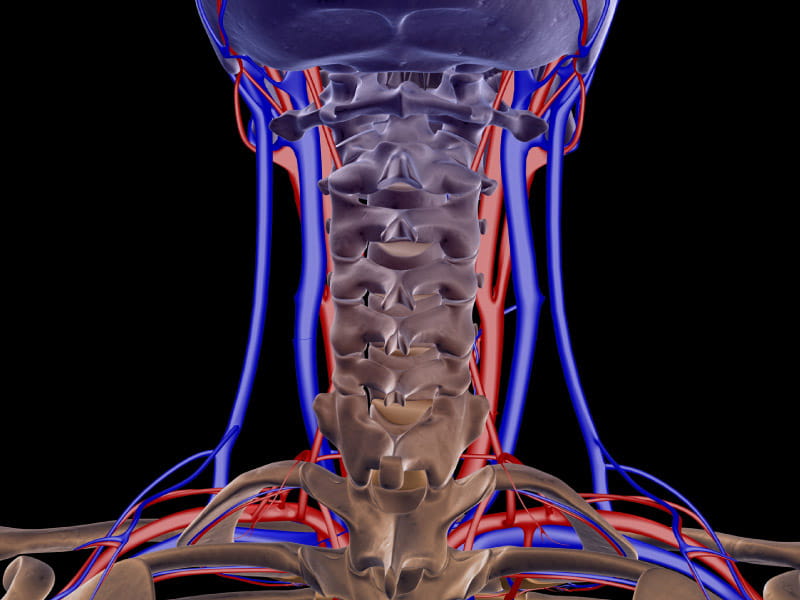Torn neck arteries may be more common than once thought
By Laura Williamson, American Heart Association News

Along each side of the neck are a pair of arteries that supply blood to the brain. It's rare for one of those blood vessels to tear. But it's one of the most common causes of a stroke in younger adults, according to a new report that comes on the heels of research showing that cases appear to be rising, especially among women.
Known collectively as the cervical arteries, the carotid arteries supply blood to the front of the brain and the vertebral arteries supply the back. A tear in one of these arteries – called a cervical artery dissection – can happen spontaneously or be triggered by an injury or drastic neck movement. The tear makes it possible for blood clots to form, which can travel to or block blood flow to the brain, causing a stroke.
Torn neck arteries are responsible for as many as 1 in 4 strokes among adults under 50, says an American Heart Association scientific statement about cervical artery dissection published this month in the journal Stroke. The report came just days after a separate study in Stroke showed cases of cervical artery dissection in one Minnesota county have risen fourfold since 2002 and twelvefold in women.
But the dramatic rise may be less about an increase in dissections and more about a greater ability to diagnose them due to growing use of noninvasive imaging, said neurologist Dr. Zafer Keser, an assistant professor of neurology at the Mayo Clinic College of Medicine in Rochester, Minnesota. He was senior author of the study in Stroke.
"It may be related to increased usage of CT scans in the emergency setting," which has risen substantially in the past two decades, Keser said.
Rising awareness of neck artery tears among health care professionals also plays a role, said neurologist Dr. Shadi Yaghi, an associate professor and division chief for vascular neurology at the Alpert Medical School at Brown University in Providence, Rhode Island. Yaghi chaired the committee that wrote the AHA scientific statement.
"People are looking for this and ordering scans when there is a suspected stroke," he said. "We're picking it up more. I don't see a strong reason why it would happen more."
While it's unclear what causes dissections that don't result from injuries, some people may be born with a genetic predisposition to weakened arteries that can tear more easily, Yaghi said. Inflammation or some infections also may make arteries more vulnerable to rupture when a person jerks or suddenly twists their neck.
"You need to have the perfect storm for this to happen," he said.
The data also suggests that health care professionals are diagnosing cervical dissections in women earlier, before they cause a stroke, Keser said. He said his study in Stroke found only 28% of women with cervical dissections experienced strokes, compared to 45% of men.
"As a community, we may be doing a better job taking women's symptoms more seriously than before," Keser said. "Maybe we're doing a better job of getting rid of our biases. But that's just my speculation."
Cervical artery dissection can be challenging to diagnose because symptoms – such as severe headache or neck pain – are so general. And sometimes a dissection occurs with no symptoms at all, Keser said. It may only be diagnosed after a person has a stroke.
"That is the most feared complication of dissection," he said. "It is one of the most common causes of stroke in young people. That's why it's very important to recognize the symptoms."
Severe headaches, for example, can be misdiagnosed as migraines, which are more common in women than men, Yaghi said. "If a woman has a history of migraines, and she's having a headache that is not similar to her typical migraine, she should seek medical attention immediately."
Immediate treatment is important, he said, because the risk of having a stroke is highest within the first few weeks.
Treatment includes blood-thinning medications, including antiplatelet and anticoagulant drugs, to prevent blood clots that can lead to strokes, and pain management to alleviate headaches and neck pain if needed, Keser said.
The AHA report suggests treatment be individualized based on a person's stroke risk and risk for excessive bleeding, which can be caused by blood-thinning medications. It also encourages health care professionals to look beyond the arteries in the neck following a diagnosis to see whether arteries in other parts of the body are damaged.
"We need to look at the patient on the whole," Yaghi said. "If they have a problem here, they may have problems in other arteries."





